| 11 |
|
| 12 |
1917 -- Harry Hirao was born in Lafayette in north-central Colorado. [At age 6, he and his parents would move to Japan to
take care of his grandparents. A decade later Harry would return to live with relatives on the farm.
At age 24 he would marry Chiyoko Alyce Yamamoto. They would live a simple life as vegetable farmers and also raise two
boys and two girls. During WWII, Colorado's governor refused to allow the Japanese population in his state to be
interned during the war. Still, life was hard for his immigrant family, which traded its farm-raised vegetables for fish
and other supplies. "The growing season too short," Harry said. In March of 1957 the family would move to California
and start a landscape business with the help of relatives. Harry would hear of an old friend, John Naka, teaching bonsai,
and join the class in the early 1960s. (Harry's great-grandfather and grandfather on his mother's side were bonsai masters.)
After 15 years as a devoted student Harry would become a bonsai teacher himself. In 1977 he would form Kofu Bonsai Kai in
Orange County with a longtime friend, Larry Ragle. In 1981 he would be honored by Prince Takamatsu of Japan with an award of
the "Ryoku Hakiju Yukosho" medal and by the Japanese Agricultural Society with a plaque for his contributions to the art of
bonsai in the United States. [Harry would be a nationally known and sought-after teacher and demonstrator. His particular field of expertise would earn him the name of "Mr. California Juniper," but he would be versatile with all species and also be known for his suiseki. He would lead several trips annually to local rivers, mountains and desert areas to search for stones and junipers with his students, weekly, especially during the cool season. He would also be a director of the National Bonsai and Penjing Museum. Friends would fund the Harry Hirao Reception Room at the John Naka Pavilion for Bonsai at the National Arboretum in Washington, D.C. Harry would donate seven graceful Eel River rocks to the Huntington Botanical Gardens in San Marino, where they would be on permanent display in the Japanese Garden. Kofu Bonsai Kai would list over 200 active members by the start of the new century and be one of the top ranking bonsai clubs in California. "How to be Happy," the first episode of the PBS series EGG, the arts show, would include a segment on Harry in 2001 "who has found happiness in remote places, capturing and training bonsai trees (an artform if there ever was one)."] 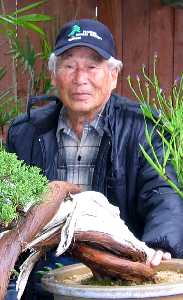
|
| 13 | 2001 -- Frederic L. Ballard, the first president of the National Bonsai Foundation, died. (A lawyer from Philadelphia, he had been introduced to the art before 1960 by his wife, Ernesta, who had recently participated in an all-day seminar and workshop given by Yuji Yoshimura. Together they built a collection which included tropical plants suitable for indoor bonsai. He and his wife were founding members of the American Bonsai Society in 1967, which Ernesta and Jerry Stowell had set in motion the previous year. A Ginkgo biloba bonsai owned by the couple had its photograph on the cover of the third issue of the ABS Journal. A noted bonsai teacher and writer whose trees are regularly exhibited in the shows of the Pennsylvania Bonsai Society and Pennsylvania Horticultural Society, Frederic demonstrated different techniques for rock plantings at the 1969 ABS Symposium in Philadelphia. With Ernesta he was on that convention's Arrangement Committee and they conducted a tour of their home and collection for the participants. Frederic later became president of the National Bonsai Foundation in 1987 and helped to elevate its fundraising and programmatic sights. He served in that office until early 1996, and became President Emeritus afterwards.) (E-mail from Betty Yeapanis to RJB April 18, 2001; "American Bonsai Society Second Annual Symposium," Bonsai Journal, ABS, Vol. 3, No. 1, Spring 1969, p. 11; "ABS News: Meet the Directors," Bonsai Journal, ABS, Vol. 4, No. 3, Fall 1970, p. 16, which gives 1955 as the date for Yoshimura's seminar. The sensei did arrive at the Brooklyn Botanic Garden on a fellowship grant in 1959, but we have not found reference to an earlier visit elsewhere in our researches. ) SEE ALSO: Aug 11. |
| 14 |
|
| 15 |
1909 -- Xu Xiaobai was born in China. [He would become a professor
of horticulture at the Nanjing Agricultural Institute, and be one of the
very first persons in modern China to engage in penjing research.
He would become mentor to Qingquan Zhao, and co-author several books and
articles with his student who himself would become one of the greatest
masters of the art in China. See also the last part of
episode #3
of Lindsay Farr's World of Bonsai, after the 7:35 mark.]
(Karin Albert personal e-mail to RJB, July 15, 2002; "A Chinese Penjing Artist
Visits America" by Karin Albert,
Bonsai Magazine, BCI, Vol. XXXI, No. 4, July/August 1992, pp. 12-13.)
SEE ALSO: Apr 20, May 25.
1939 -- Max J. Miller was born. [He would be growing bonsai as a hobby since 1963 when he'd come upon the first Brooklyn Botanic Garden booklet, Handbook on Dwarfed Potted Trees: The Bonsai of Japan (1953). A year or so later he would visit the BBG collection in New York and then read their Handbook on Bonsai: Special Techniques book (1956). For the first ten years he'd experiment on his own, the first three or four, of course, just learning how to keep the trees alive. Being a mechanical engineer, he and his family would move around the Midwest before settling in Wisconsin. There he would spend twelve years with the Coulee Region Bonsai Club of La Crosse, Wisconsin. He met several young Japanese engineers in the next several years while attending annual International Gas Turbine conferences. Max would ask them if they raised bonsai. He knew that they would say no, because they worked very long hours for their companies. Then he would ask them who raised the bonsai, and they would reply the old men. In response to the pestering, one of his Japanese colleagues said "come to Japan and I will show you bonsai." So, during a business trip to Japan in 1983, this colleague took Max to see two bonsai nurseries in Okayama Prefecture. The owner would not be able to speak English and Max would not know Japanese, but the two would end up having a wonderful conversation about bonsai with his colleague serving as an interpreter. The owner would be impressed by the gaijin (foreigner)'s interest. Max would have two articles published in BCI's Bonsai magazine, "Thick trunks," 18(9):303 ['79] and "Finding an exhibit site," 22(5):173 ['83]. He and his wife Shirley would then come to Arizona and join the Phoenix Bonsai Society about 1985. Shortly after joining, Max would give a slide presentation of his trip to Japan. While living in Arizona for 22 years, as a member of PBS he would learn from club experts as well as from professionals from California. Max would be the PBS Show Chair from 1988-89, VP 1989-91, President 1991-93, and Mentor 2008-10. Max also would have what RJB considers the finest creosote / Greasewood (Larrea tridentata) bonsai ever, between 1987 and 2003. (While on the almost annual California trip in the Spring of 1997 to the opening of the GSBF Collection South at the Huntington Library, Art Galleries and Botanic Garden, Max would help educate the then PBS President RJB's eye to the wonders of forest plantings. An elm composition on a long rock base that had numerous small plants adding dimensions to the piece would feature a small gravel path down the center from front to back. This overall planting was so detailed that I was actually expecting a miniature deer to come walking up over a small rise towards the front of the piece.) The Millers would then move to Iowa in 2007, joining the Iowa Bonsai Association, where Max would be Member at Large on the Board of Directors from 2009-11 and be presented with the George Rupp Service Award in 2010. Max would teach a dozen introductory classes on bonsai in his home. He would help form the Nebraska Bonsai Society and would also teach several novice workshops for the club from 2012 to the present.] 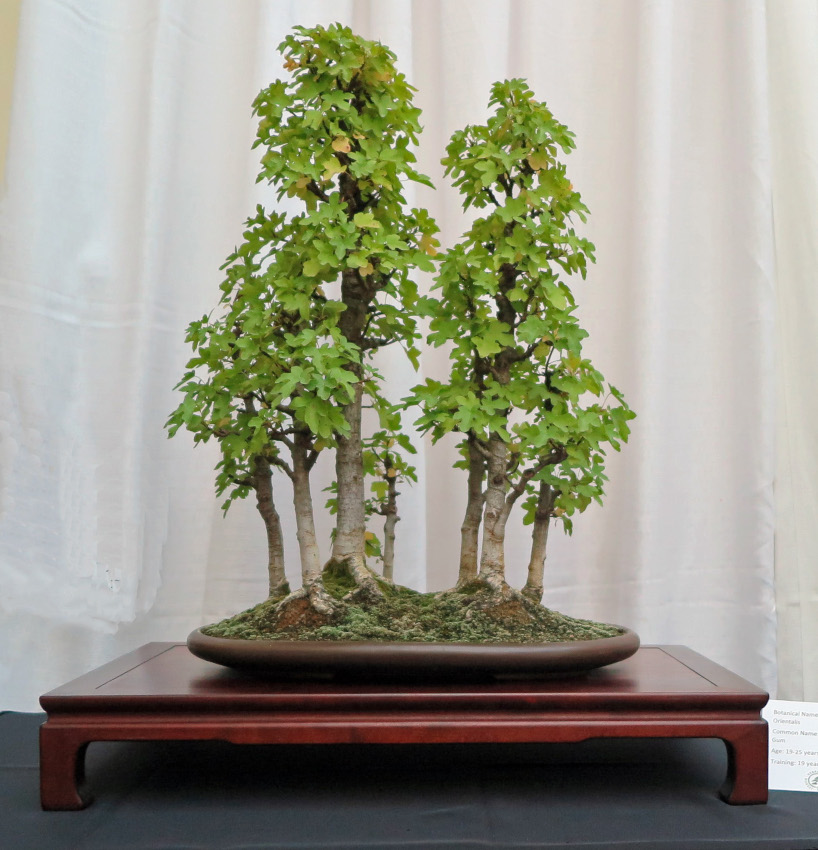
Max Miller's Liquidamber Forest in 2024 Fall Show,
originally created in a club demonstration March 2005 (photo courtesy of Max Miller, 11/08/24)
Max Miller and Living Art Award Ribbon from 2021 Iowa State Fair,"
(The Indices 2004, BCI, pg. 190;
"Introduction
to Bonsai Workshop with Max Miller," Lauritzen Gardens, Nebraska, May 16, 2020 (event cancelled because of COVD-19 pandemic,
but another is scheduled for 2024, "Bonsai Workshop");
Baran, Robert J. Designing Dwarfs in the Desert, 1997, pg. 64; MM email to RJB 11/08/24 with additional information and
clarification)
(photo courtesy of Max Miller, 11/08/24) 1970 -- Beginning today and running through Sept. 13, a large-scale bonsai and suiseki show was held in conjunction with the Osaka World Exposition in Senri. Sponsored by the Nippon Bonsai Association, the Japan Suiseki Society, and the Japan Satsuki Club, the display was impressively staged on outdoor benches in one portion of the sixty-four acre Japanese garden area. New replacements would be brought in so that during the run approximately two thousand of the most famous and honored trees in the land would be displayed, nearly every one in a 200 to 300-year old Chinese pot. The pots were collectors' items and many were as well known and named as the trees they supported. Morihiko Tomita was the manager in residence of the exhibit, having sold half of his 50-year collection of 600 small bonsai to come to the Expo for six months. (Mr. Tomita was also the discoverer of the mountain where "Kikukaseki" or chrysanthemum stones are found.) ("Bonsai's Top Show" by Dorothy S. Young, Bonsai Journal, ABS, Spring 1970, pp. 3-4) 2006 -- Potter Don Gould was killed in a car accident while trying to go to the aid of another motorist. He was born in 1951 and went to Duquesne University in the late 1960s and early 70s. He was described as a "lovable hippie" who managed the arts and crafts center in the student union. After graduation he was able to continue producing art while making a living out of his creative enterprises. Over the years he did graphic design and communications work for various Pittsburgh groups, including WQED and Carnegie Libraries. He was a ceramicist, product designer, printmaker and social entrepreneur. Working with potters and ceramic engineers, he started an organization PURE WATER 4 ALL dedicated to improving water quality in Third World countries with the use of relatively simple ceramic filter pots. He was probably one of the top three American potters who made bonsai and suiseki containers. His pots were known nationally and internationally, and he had been one of the lecturers in May 2005 at the WBFF Convention in Washington, D.C. Shortly after leaving a morning meeting of the Rotary Club in mid-March 2006, Don stopped to check on one of the other drivers involved in a small traffic accident. Another driver came up around the bend of the ramp where this was at and lost control of his car on the icy roadway, pinning and killing Don at the scene. [He leaves behind his wife, Sally; son, Ian; and daughter, Abby. In honor of Don, a deep water well in a natural reserve in Nicaragua will be drilled, underwritten by the Rotary Club of Forest Hills and assisted by the Tulsa chapter. Also, please see this recent posting about some of his pots.] 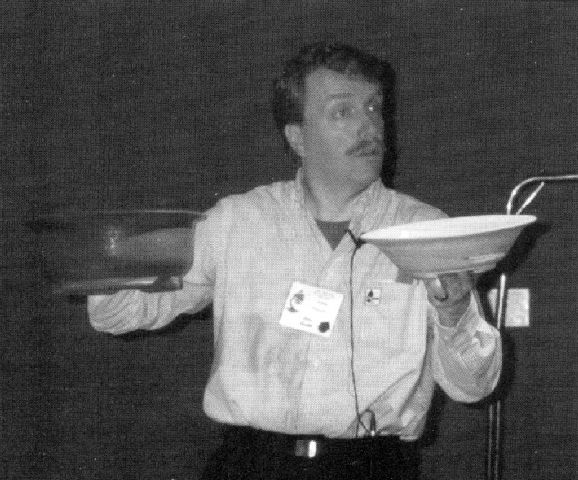
Don Gould talking about pot selection at the ABS 1995 Convention
(e-mail by Peter Aradi to the Internet Bonsai Club, April 25, 2006,
http://internetbonsaiclub.org/index.php?option=com_smf&Itemid=133&topic=18810.0;
Sostek, Anya "Obituary: Donald J. Gould / Artist in ceramic, glass and bonsai,"
Pittsburgh Post-Gazette, March 17, 2006; "In Memorium: Don Gould,"
http://pghaccelerator.org/blog/globeshakers/, March 20, 2006.)
(Bonsai Journal, ABS, Summer 1995, pg. 69) |
| 16 |
1927 - Cheryl Mae Kreighbaum was born in Elkhart, IN. [She would become famous
in local bonsai circles some four decades later under her married name, Cheryl Owens.] ("Cheryl Owens," South Bend Tribune, April 28, 2017, http://www.legacy.com/obituaries/southbendtribune/obituary.aspx?n=cheryl-owens&pid=185230698&fhid=8850) SEE ALSO: Apr 25 1961 -- Pedro J. Morales Orellana was born in Chicago, IL. [His family would move back to Puerto Rico when he was only three months old. Starting with his family in the ornamental plant field, he would later work part-time in Jardin Selecto during his studies of computer programming at the University of P.R. A teacher during Pedro's first year in university in 1980 would assign the latter the subject of bonsai for a research project. From this Pedro would meet Hugo Storer, the first person of bonsai in Puerto Rico. Pedro would go on to become prominent in Central American bonsai. He would demonstrate at the 1992 and 2000 MidAtlantic Bonsai Societies Symposia in New Jersey; the 1993 2nd World Bonsai Friendship Federation Convention in Orlando, FL (joint with the American Bonsai Society and Bonsai Clubs International meetings); the 2001 4th WBFF in München, Germany and 2009 6th in Puerto Rico; the 1998 BCI Convention in Puerto Rico, 2002 BCI in Orlando, FL, and the 2007 BCI/FELAB in Puerto Rico; the 1999, 2001, 2005, 2007, 2008, and 2016 Federatión Latino Americana de Bonsai Encounters; the 2004 and 2007 International Bonsai Arboretum seminars; the 2007, 2013 and 2015 International Bonsai, Suiseki and Tea Exhibitions in Nitra, Slovakia; the 2007 and 2011 Golden State Bonsai Federation Conventions in California; the 2008 1st U.S. National Bonsai Exhibition in Rochester, NY; the 2009 10th Asia-Pacific Bonsai & Suiseki Exhibition and Convention in Taiwan; the 2009 Taiwan Bonsai Creator Association Exhibition (Chwa Fong); the 2015 and 2017 Brussel's Bonsai Rendezvous in Olive Branch, MS; and the 2019 2nd U.S. National Shohin Bonsai Exhbition in Kannapolis, NC.]
Pedro Morales, 06/18/2004.
("Biography - Pedro J. Morales,"
http://www.pedrojmorales.com/bio.htm
) SEE ALSO June 28
(Photo courtesy of Alan Walker, 05/11/07) 1965 -- Farrand Bloch was born in Holland. [His interest in Japanese Zen gardens would eventually evolve into bonsai and later studies under Hotsumi Terakawa, Yuji Yoshimura and Suchin Ee. Farrand would travel to Japan and then have workshops at Shigeo Kuroso's bonsai garden near Omiya. In 1993 he would open his studio garden in Voorschoten, Holland called Sozo. The ground floor of the house and the garden would be turned into a Bonsai Center. Farrand would thus begin a long journey of giving demonstrations and workshops, including during BCI 1998 in Puerto Rico. That year he would end up taking over the four-year-old magazine Het Bonsai Blad, and together with René Rooswinkel, his publisher and "partner in crime," Farrand would edit and manage to make the magazine grow. And in 1998 they would move to Opheusden in the East of the Netherlands. They would merge their magazine with Bonsai UK magazine in 2000 to form Bonsai Europe. The Dutch language edition would be released that summer with Hein Dik Barentsen as its editor. The first French edition with Michel Sacal as its editor would be started in May 2002, the year Farrand and Rene would close their Bonsai Center to concentrate on the magazine. A German edition with Krista Leach would come in May of 2003 and the Italian edition with Massimo Soranzio would come in 2006. Bonsai Europe quickly would become one of the most respected bonsai publications in the world, Farrand acting as editor throughout its growth. The magazine would be merged with the American Bonsai Today in 2007 with a complete overhaul of the magazine, including the name change to Bonsai Focus. This new publication would define the mainstream bonsai media in the West with Farrand at the helm. He would also edit the biennial series of books titled The best of bonsai in Europe: Ginkgo Bonsai Award. He and Václav Novák of the Czech Republic would then be lead demonstrators at the 2009 National Convention in Pretoria, South Africa. The following year Farrand, Kunio Kobayashi of Japan and David Easterbrook of Canada would judge over 225 trees by 95 exhibitors from 27 states at the 2nd US National Bonsai Exhibition in Rochester, NY.] ("Profile: Farrand Bloch," http://www.artofbonsai.org/forum/viewtopic.php?t=1089; "A visit to Farrand Bloch and René Rooswinkel September 1997," http://www.thebonsaiguide.com/BonsVBS.htm; Dupuich, Jonas "Bonsai Focus, Posted in 'Reflections'," http://bonsaitonight.com/tag/boon-manakitivipart/). SEE ALSO: Mar 10, Sep 3. 1968 -- Third generation penjing master Yee-Sun Wu entered the First Urban Council Flower Show in Hong Kong and won the Kadoorie Championship Cup for Bonsai. [Over the next six years he would enter or put on a few other exhibitions of his masterpieces to large crowds, publish two editions of his book Man Lung Garden Artistic Pot Plants, deliver public lectures, and contribute articles on dwarf tree culture to various magazines and newspapers. This would all stir up the interest of the Chinese people to revive this traditional art which had become synonymous with Japan.] (Man Lung Artistic Pot Plants by Yee-Sun Wu, pp. 24, 27-28) SEE ALSO: Mar 27, May 2, May 11, Jul 7, Dec 14 |
| 17 |
1934 -- The first Kokufu
kai bonsai exhibition began today and ran for four days at Ueno Park,
Tokyo, in the grounds of the Tokyo Metropolitan Art Museum. Since
the gallery has always been extremely sensitive in the types of shows
that it allows there, this gave bonsai a new status. It was now
unquestionable that bonsai was an accepted and respected art
form. [A second Kokufu Ten show would be held for six days in early December, and
after that the shows would eventually become annual events -- being suspended only
during the Pacific War and then being resumed in 1947. These
oldest continuous shows would quickly become also the most important
and famous bonsai displays in both Japan and the world.]
(Koreshoff, Deborah R. Bonsai; Its Art, Science, History and Philosophy
(Portland, OR: Timber Press, 1997), pg. 10, footnote 31 derived from
Kobayashi, Norio, "History of Bonsai" -- excerpted and translated from
a series of articles appearing in "Bonsai-Tsu," in
Western Suburbs Bonsai Journal, Oct. 1972, pg. 10; ) SEE ALSO: Feb 11
|
| 18 |
1902 -- Takita "George" Fukuma was born in Japan, near Hiroshima. [He would
immigrate to the United States in 1919, start school in Seattle, Washington and master the English language.
He would graduate from Business College and it was during these years that he would begin his interest in the
art of bonsai. In 1942, groups of individuals of Japanese ancestry on the west coast, both citizens and
aliens, would be ordered to be relocated inland, outside of the Pacific military zone. Bonsai enthusiasts
would have to leave their bonsai collections when they were relocated to
Wyoming and Colorado internment camps. In 1944 a group of these
would be released and move to Denver. George, who would be coming from Wyoming, would start a downtown
grocery business in the Mile High City that year, which later would become a thriving import business. In later
years, this would be combined with bonsai. In 1945, George and seven others (from Colorado camps: Shiichi
Fukuhara, Ben Yamakishi, Sam Naka, George Inai, Kai Kawahara, Mitsutaro Tawara, and one other gentleman) would
form the "Denver Bonsai Club" to join in fellowship and advance the Japanese art of bonsai. The meetings
were unique in that only Japanese was spoken and lectures on the topics were formally led by a sensei
(master artist). After the formation of the Denver Bonsai Club, interest in the Denver area would grow
and there would be up to 75 members in the club, all of whom were Japanese. Members would get together
at various homes to learn from each other and also from those members who would come from California with bonsai
experience. The club would hold annual shows at various public places such as the
Denver U.S. National Bank,
Simpson Methodist Church, and the
Denver Buddhist Temple. Membership would decline
in the 1970's with the passing of many of the older senior members and the aging of the rest of the club.
In response to this, George would urge the senior and junior clubs to merge to become the Denver Bonsai Club.
This would eventually occur in 1975, but after George's death the previous November. The merger of the two
clubs would be a good idea since the Junior Bonsai Club was growing and had around 76 members. These
members would work hard to promote bonsai thru the annual show held at the
Denver Botanic Gardens. The
Senior Bonsai Club's older members would have the best show quality trees. All in all, it would be an
excellent match and lasting legacy for George, who taught bonsai at the DBG for about six years and at Kansas
City for at least eight years. George would also be considerd a most influential member of the Japanese
community in Denver and would hold an active position on its governing board. He would be the one contact
in Denver for any visiting Japanese dignitary of the consul. With his wife, Marg, he would always be
entertaining some interesting personage from Japan or out-of-town. In 1954, a group of twenty Japanese
from Denver, including George, would finally achieve their U.S. citizenship.]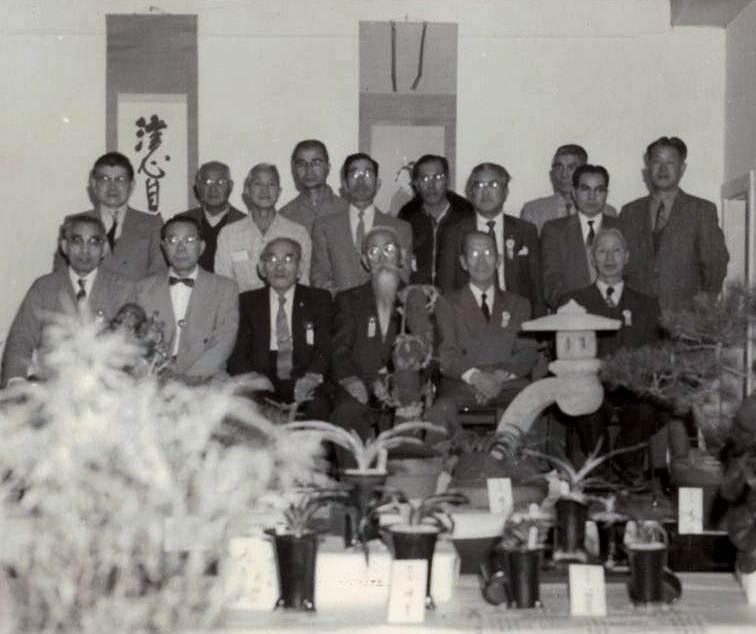
Denver Bonsai Club -- Official 10th Annual Show Photo -- 1954.
U.S. National Bank Lobby (22nd & Lawrence) Oldest known club photo. Founding members' names are in bold. Front Row, left to right: Mr. George Inai, Mr. George Fukuma, Dr. Miyamori, Mr. Shiichi Fukuhara, Mr. Suzuki, and Mr. Suehiro. Back Row: Mr. Yiyahara, Mr. Mitsutaro Tawara, Mr. Mitsujnru [sic], Mr. Saito, Unknown [= unknown founding member?], Mr. Hoshizima, Mr. Joda, Mr. Sam Naka, Mr. Kai Kawahara, and Dr. Ito (Photo from "The History of the Rocky Mountain Bonsai Society") 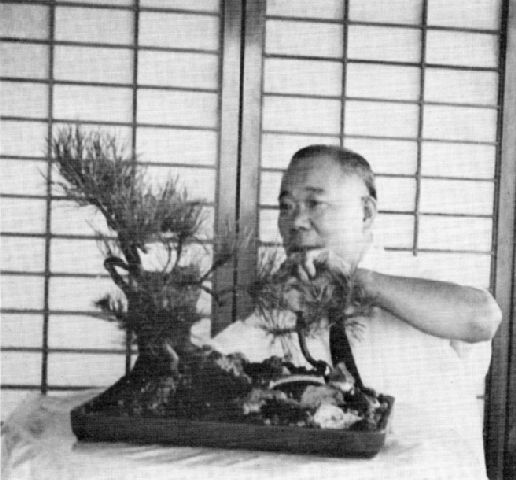
George Fukuma (Neil, Mary "George Fukuma (1902-1974),"
(SSN Master File by Birthdate; Neil, Mary "George Fukuma,"
Bonsai Journal, ABS, Vol. 9, No. 1, Spring 1975, pg. 14; "The History of the Rocky Mountain Bonsai Society,"
http://www.rockymtnbonsai.org/history-rocky-mountain-bonsai-society;
Robinson, Jim "The History of the Rocky Mountain Bonsai Society,"
http://web.archive.org/web/20100105002824/http://www.rockymtnbonsai.org/html/ClubHistory.htm;
"RMBS HISTORY, A Tribute to Our "First Branch" 1919 [sic] - 1974," RMBS October 2011 Monthly Newsletter, pg. 4,
http://bonsai2012.org/sites/default/files/images/OCT%202011%20Newsletter.pdf;
"George Fukuma Sale Gallery," http://www.ps3.shop-1st.biz/shop/0-George-Fukuma-1-GALLERY.html;
"Takito (George) Fukuma,"
https://www.myheritage.com/FP/genealogy-search-ppc.php?type=&action=person&siteId=52266882&indId=9000035&origin=profile;
and there is this October 2019 podcast, Bonsai Behind Barbed Wire,
exploring part of the club's early history, and this July 2020
video filling in some more details.) SEE ALSO: Jul Also, Nov 28
ABS Journal, ABS, Spring 1975, pg. 14) 1916 -- Shigeru Nagatoshi was born. [He would study bonsai under his teacher, Frank Iura, and in 1965 be encouraged to open Fuji Bonsai Nursery in Sylmar, CA with his son, Roy.] (Per personal e-mail from Max Miller to RJB, Apr. 30, 2006; Banting, Donna "Roy Nagatoshi and Pomegranate," Bonsai Magazine, BCI, Vol. XXX, No. 1, January/February 1991, pg. 3.) SEE ALSO: Feb 19, Jun 6 1961 -- Thierry Font was born in France. [He would go on to be influential in that country's bonsai scene.] ("Thierry Font; in memoriam," http://www.bonsaicentersopelana.com/2014/04/thierry-font-in-memoriam.html) SEE ALSO: Apr 21 |
| 19 |
1951 -- Nobuyuki Kajiwara was born in Fukuoka, Japan. [He would
study Middle Eastern Languages and literature at the Osaka University
of Foreign Studies, then at the Rijks Universiteit at Leiden,
Netherlands. Travelling widely in Europe for both business and
pleasure, in 1983 he would then return to Tokyo. At the office of
the City and Port of Rotterdam there he would be given the task of
organizing a Japan Festival in Rotterdam in 1984. One of the
events for that would be a bonsai exhibition. While there he
would have his first introduction to bonsai and make an acquaintance of
Terukichi Katō, the younger brother of Saburō and Hideo Katō.
Kajiwara would be Terukichi Katō's apprentice at the family's Masei-en
Shiten nursery from 1986 through 1991, when he would then obtain a
diploma from the Japanese Cooperative of Professional Bonsai Nurseries
(Nihon Bonsai Kyodo Kumiai). Returning to Europe that year, the
next he would be appointed chief instructor at the "Universita del
Bonsai" at Parabiago near Milan for their 3-year bonsai courses.
In 1993, Kajiwara would be awarded Gold medals at the International
Garden Show held in Stuttgart for the bonsai exhibition jointly
produced with the client, Helmut Rueger. Two years later he would
also jointly produce a bonsai exhibition at the castle in Buedigen,
Germany, and then another in 1998 at the "Palmen Garten," the municipal
botanical garden of the city of Frankfort. The next year would
see him producing a successful bonsai exhibition for the auction house
Sotherby's in London. He would then hold annual workshops with
several groups in the U.K. as well as attending private bonsai
collections on a regular basis for clients in the U.K., Germany, Italy,
and Spain.]
("Noboyuki [sic] Kajiwara - A Portrait,"
http://www.bonsai-corner.ch/nobu_portrait1.htm
; "Nobuyuki Kajiwara,"
http://www.dai-ichibonsai.com/tutors.asp) SEE ALSO: Oct 8
|
| 20 |
1896 -- Frank Ekizo Iura was born. [He would come to California in 1915 and live with relatives in Anaheim. Like many other
young Japanese men, he would return to Japan to marry and then come back to California with his new bride. He would continue his
business in San Francisco until 1932 when he would move to Los Angeles and, together with a partner, open a nursery center.
He and his family would be moved to Fort Lupton, Colorado during WWII. After this, he would return to Los Angeles and pursue
a career in landscape gardening. Iura's interest in bonsai would develop at this time.) He and several others of his Japanese friends would found The Los Angeles Bonsai Club in 1960.]
(SSN Master File by Birthdate; Elias, Thomas S. "History of the Introduction and Establishment of Bonsai in the Western World,"
http://web.archive.org/web/20120613015804/https://www.bonsai-nbf.org/site/images/Elias_Paper.pdf,
pp. 66-67) SEE ALSO: Jun 6, Nov 5
1975 -- Fifty trees that would become the permanent National Arboretum Bonsai Collection were accepted by Arboretum Director Dr. John Creech in ceremonies in Tokyo, Japan. Presented by the Nippon Bonsai Association in honor of the upcoming U.S. Bicentennial, half of the miniature trees were donations from private sources, including some from members of the Royal Japanese family. The remaining trees were purchased with funds from the Japan Foundation, a semi-official agency which also covered expenses for expert artists to come to the U.S. to instruct American personnel in proper care of these irreplaceable treasures. Please see this video of the story, Bonsai Fly to U.S.A.. There is also this Japanese language video which includes other materials. (Bonsai Magazine, BCI, June 1975, pg. 139) SEE ALSO: Feb 19, Mar 21, Apr 1, May 2, Jun 9, Jul 9, Jul 21, Aug 6, Aug 7, Aug 26, Sep 30, Oct 1, Oct 15 |